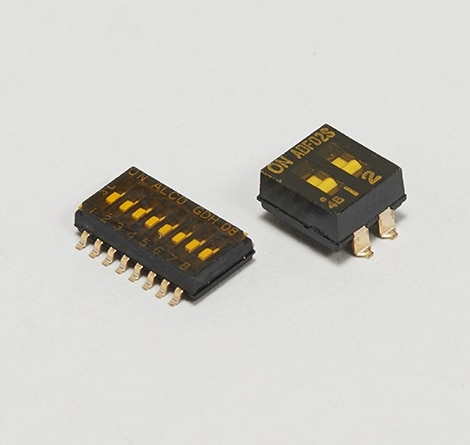
What is a DIP switch?
A DIP switch is a manual electronic package that is composed of a series of tiny switches. Available with a variety of actuator styles and sizes, these switches can be used in a range of applications in computers and peripherals. Our DIP switches range in position sizes from 1 to 12, with the capability of adding our end stackable switches. We also offer SIP switches that can package multiple resistors and RAM chips with a common pin. Our SIP and DIP portfolio includes surface mount DIP switches and through hole DIP switches.
Find by top-searched types
Browse a selection of DIP switches
- Slide DIP Switches
- Piano (Side Actuated) DIP Switches
- Surface Mount DIP Switches
- Through Hole DIP Switches
- Single Pole-Single Throw (SPST) DIP Switches
- Single Pole-Three Throw (SPTT) DIP Switches
- Multiple Single Pole-Double Throw (mSPDT) DIP Switches
- Double Pole-Single Throw (DPST) DIP Switches
- Double Pole-Double Throw (DPDT) DIP Switches
- Four Pole-Single Throw (FPST) DIP Switches
A DIP switch has a rectangular casing and two parallel rows of connecting terminals. Common DIP switch features include tape and reel packaging, imprinted markings, CE and CSA certifications, UL listed, dustproof, and waterproof or weather resistant.
A DIP switch can be normally open (NO), normally closed (NC), or three stage. Types of DIP switches include a slide actuator, which can be configured to have raised or recessed slides; a rocker switch, which can be configured to have raised or recessed rockers; and a piano switch, which is a side-actuated lever that has “keys” to push down to actuate.
DIP switches are normally found on motherboards, expansion cards, and auxiliary cards, and are often used to hold configuration settings on computers and peripherals like circuit boards and modems.
A single inline package (SIP) switch is a computer chip package that has a single row of connection pins. The body of a SIP switch is usually made of ceramic or plastic, with a lead count that typically ranges between 4 and 64. There are three SIP switch styles: conformal coated, uncoated, and molded. SIP switches collectively arrange RAM chips on a small board by either using a DIP process or surface mounting device process.
The board includes a single row of pin leads that connect to a socket on a system or a system-expansion board. Small-form SIP switches are typically parallel-array devices of common value components like resistor arrays and diodes. Large-form SIP switches are typically hybrid circuits like timers or oscillators.
Select Applications
DIP & SIP Switches
Alcoswitch Next Generation Dip Switch - ADE & ADF Series.
TE Connectivity’s (TE) ALCOSWITCH Next Gen. DIP switch ADE and ADF series are designed for space-saving and streamlined manufacturing with high contact pressure allowing for aqueous cleaning without the need for tape sealing. The ADE and ADF series are available in through-hole and surface mount options. Style of actuators is based on series: ADE with extended actuators, ADF with flush actuators. ADE/ ADF is available in both tube and tape/reel packaging options
Benefits
- Raised (extended) or recessed (flush) for design flexibility.
- Through-hole & surface mounted.
- An extremely high contact pressure system allows aqueous or solvent cleaning without a tape seal.
- Gold contact plating for high reliability and corrosion resistance.
- Tape and reel packaging available for quick pick-and-place assembly
Applications
- Industrial and automated control boards
- Fire and security systems
- Thermostats
- Elevator/Escalator
- Telecommunication device
Key Feature
- Better space management because of low profile design, 30% smaller in size compared to conventional dip switches available in the market.
- Sliding-type contact ensures better performance and higher reliability when compared to conventional seesaw-type contact
